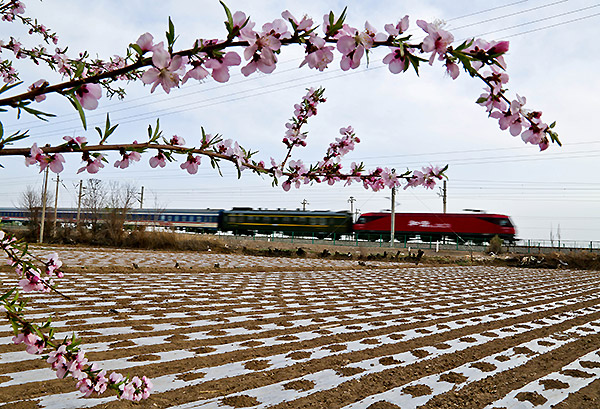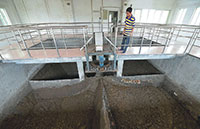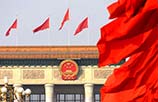Jiangsu follows in footsteps of a hero
By Zhao Huanxin in Lianyungang, Jiangsu (China Daily) Updated: 2015-12-04 15:56
 |
|
A Urumqi-bound train that starts from Lianyungang passes through Zhangye, Gansu province on July 20, 2015. The section is part of the new Eurasian Continental Bridge that links China's Lianyungang, a gateway to the Pacific Ocean, to Rotterdam, Netherlands, and the port's access to the Atlantic Ocean.[Photo/IC] |
Coastal province draws on history and its unique geographical advantages to rebuild 'Silk Road' ties with international partners
July 11, 2015 was an average day, until it's viewed from a historical perspective.
On that day, a cargo train rolled on the new Eurasian Continental Bridge that links China's Lianyungang, a gateway to the Pacific Ocean, to Rotterdam, Netherlands, and the port's access to the Atlantic Ocean.
On exactly the same date 610 years ago, a fleet of 130 ships commanded by Zheng He set sail from a nearby port in Suzhou, also in Jiangsu, starting a series of historic voyages on the maritime Silk Road that would eventually lead him to ports throughout Asia and Africa.
Six centuries on, the enterprising spirit of the great navigator in the Ming Dynasty (1368-1644) seems to have been imparted to the people of the eastern province. They have vowed to champion a new wave of Chinese globalization by taking advantage of the country's ambitious plan to revive the ancient land and sea Silk Road.
"Drawing on the province's unique history and solid reality, Jiangsu is determined to play a pioneering and leading role in China's Belt and Road Initiative," Chen Zhenning, a top provincial planner, told a delegation of journalists in mid-November.
Jiangsu is one of the wealthiest provinces in China. It hopes to "expand opening-up space" by availing itself of its stellar position in the Belt and Road Initiative, said Chen, director of the provincial development and reform commission.
The initiative, which comprises the Silk Road Economic Belt and the 21st Century Maritime Silk Road, was proposed by President Xi Jinping during an overseas visit in 2013. It is designed to connect countries in Asia, Europe and Africa, and promote cooperation among them.
Jiangsu, geographically situated at the juncture of the Belt and the Road, answered the challenge with a massive project. In May last year, it joined Kazakhstan to launch an international logistics terminal in Lianyungang, with total investment of $98 million for the first phase of construction.
Lianyungang is the eastern end of the new Eurasian Continental Bridge. The logistics center in the port city would enable products from Central Asia to be more efficiently shipped to the rest of the world.
In February, regular cargo trains began to shuttle weekly between the port and Almaty, the financial and technological hub of Kazakhstan, and within half a year, they had shipped 1.33 million metric tons of cargo.
The terminal is, in fact, the first project implemented in China since the Belt and Road Initiative was conceived, Chen said.
- Beijing lifts red alert but smog will be back in two days
- Psychiatrist links smog, depression
- Weather a bonanza for taxi services
- Lawyer: Top court OKs death sentence in poisoning case
- Power for ministries to be clarified
- Red alert helps to reduce pollutants, say experts
- Elderly people snapping up dance products online
- Aging population could shrink workforce by 10% in China
- Severe smog brings mask panic buying
- Foreign economists advise on blueprint for next five years







